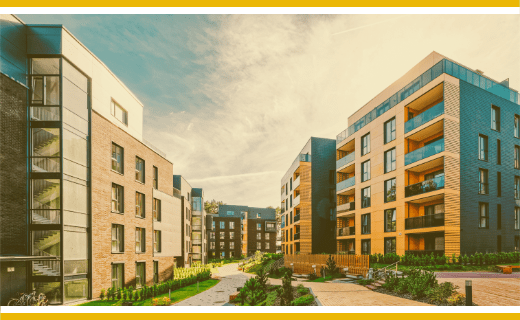20 July 2022
It’s important for property owners, and those looking to purchase a property, to know the difference between freehold and leasehold properties. Here we take a look at the key differences between them and how FirstPort works with freeholders and leaseholders to effectively manage a development.
What is a freehold property?
A freehold property is when you own the building and the land it’s on. As a freeholder, you are responsible for the maintenance of the whole building, as well as the land.
What is a leasehold property?
With a leasehold property, you own the property but not the building or the land it’s on, and you may pay ground rent to the freeholder (also known as the landlord). When you purchase a leasehold property, you enter a legal agreement with the landlord to own the property for a set period of time, referenced in a lease agreement. Leasehold properties are normally flats or apartments, but a house can also be leasehold.
Owners of leasehold properties pay a service charge, either to the freeholder directly or to the managing agent appointed to look after the building on their behalf. This fee contributes to the general maintenance and upkeep of the building and the communal areas. It’s usually paid in advance once or twice a year.
What if leaseholders want more of a say in the running of the development they live in?
In some cases, leaseholders can have more of a say in how their development is run by becoming a Director of their Resident Management Company (provided an RMC has been set up by the developer) or Right to Manage Company (provided leaseholders have taken the statutory right to take over management from the freeholder).
Resident Directors are required to meet a range of statutory requirements. Typical responsibilities include:
- Ensuring the building is compliant with all relevant legislation and health and safety regulations
- Arranging repairs and maintenance work
- Maintaining all statutory records and reporting any changes
- Keeping an accurate record of development finances
- Deciding how service charge funds are used to maintain the development
- Making management decisions on behalf of residents and leaseholders
- Ensuring the right insurance is in place, to protect the development and themselves
How FirstPort work with Resident Management Companies and Right to Manage Companies
The role of a Resident Director is complex and requires knowledge of landlord and tenant law, building construction, health and safety regulations, basic accounting and more. That’s why many resident managed developments choose to appoint a professional property manager, like FirstPort, to help them meet their responsibilities and make sure the development is safe, clean and comfortable.
With over 40 years’ property management experience, we’re here to provide expert support for Resident Management Companies and Right to Manage Companies. We already work successfully with over 1,600 resident managed developments.
Find out more about how we work with resident managed developments by reading our blog: How Property Managers, Resident Management Companies and Right to Manage Companies look after a development.
Partner with FirstPort today
Are you looking for a property manager, or considering switching to FirstPort? Our team are on-hand to help you and answer any questions. Simply complete the form below and we’ll be in touch:
-
![]()
Resident Managed Developments
-
![]()
The Role of a Resident Director
-
![]()
The Resident Director Survey 2022
-
![]()
03. How we support Resident Management Companies (RMCs)
-
![]()
Top ten traits of effective Resident Directors
-
![]()
Smooth sailing at The Waterways with our RMC partnership
-
![]()
Getting things shipshape with Right To Manage Directors at Centre Quay
-
![resident directors smiling]()
How Property Managers, Resident Management Companies and Right to Manage Companies look after a development











